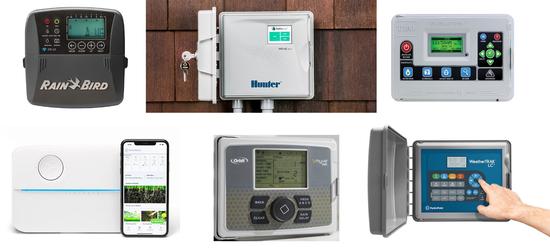Winter 2023
Smart Controllers for the Win! Choose Which One is Best for You
by Lori Palmquist

Smart irrigation controllers are the intelligent choice for our gardens. They automatically adjust the irrigation schedule daily, based on changes in the weather. They’re like a thermostat for your landscape. And how great is it that our water providers are literally paying us to use them?
Did you know that smart controllers have been around for more than 20 years? And did you know they can potentially lower your water use (and thus your water bill) by at least a third during the irrigation season (generally May through October in the Bay Area)? They’re already required by our landscape ordinance in California (MWELO). This is because they’re a VAST improvement over the scheduling habits most people have with conventional irrigation controllers. They automatically adjust your irrigation based on real-time weather. Many of them even look at the forecast and adjust based on that. And most of them provide for remote access and programming.
Smart controllers have literally revolutionized irrigation, and the water savings are pronounced and undeniable. With the advent of WiFi controllers, and the resulting saturation of the smart controller market (pun intended), the prices have been driven down by demand and intense competition among controller manufacturers. And with the water districts providing such great rebates, the barrier to using these valuable water savers has vaporized.
Know that there is a learning curve to using this smart technology. Many manufacturers offer extensive training tutorial videos and literature on their websites. And technical support crews available by phone are extremely helpful in assuring that the controllers are installed, programmed, and monitored properly.
An important point needs to be made here. Inefficient, problem-riddled irrigation systems will not magically improve their performance if a smart controller is added. If anything, a smart controller will quickly reveal the weaknesses of an inefficient or faulty system. But installing one is a good start. At the very least, the scheduling will improve. Then you can address the repairs and upgrades to the system over time.
List of Choices
Any smart controller considered should come from the EPA WaterSense list, whether you use a rebate program or not. Every controller on this list has undergone rigorous third-party testing to ensure it is effective in conserving water. And the water district rebate programs require you to choose a controller from this list. Here’s a link to the online list:
https://lookforwatersense.epa.gov/Product-Search-Results-IrrigationController.html
So, let’s talk about how to choose which controller would be best for you. If you look over the list at the link above, you’ll see there are 971 controller models listed. But don’t worry. I’ll trim it down to make your selection process much less daunting.
There are 22 brands of controllers to choose from. But for our purposes, for residential use, the list can be narrowed down to around 16 brands.
When deciding on which smart controller is best for you, consider the following questions:
- Are you a “hands-on” person, or do you have a gardener or other landscape professional who would be able to take on the technological aspects?
- How would you like the controller to access weather data?
- Your home’s WiFi
- Cellular access (an annual fee of at least $250 would be charged)
- On-site weather sensor
- How many irrigation zones exist on your property, or could be added in the near future?
- Do you have a gardener? Does this person have a favorite smart controller?
- Would you prefer a controller that can ONLY be accessed by an app, or one that has an app AND the option to adjust and monitor operations through buttons and dials on the device?
Here’s a list of smart controllers that are popular in the Bay Area, in alphabetical order:
- Hunter Hydrawise (WiFi)
- Hunter (any model) with Solar Sync (onsite sensor)
- HydroPoint (cellular)
- Irritrol Climate Logic (onsite sensor)
- Orbit B-Hyve (WiFi)
- Rachio (WiFi)
- Rain Bird ST8 (WiFi)
- Toro Evolution (onsite sensor)
- Weathermatic (onsite sensor and/or cellular)
You can further filter down this list by deciding whether you prefer a controller that uses WiFi, cellular, or an onsite sensor to acquire its weather data. The most popular method by far is WiFi. It’s free, and the weather stations are professional grade and maintained. So, if you’re interested in a WiFi controller, this narrows down the list to four brands. Now we’re getting somewhere!
Here is some further advice for choosing the best controller for you:
- Get recommendations from friends, family members, or neighbors
- Ask your gardener which controller they prefer
- Contact your local irrigation store and ask which controllers are most popular, and why
- Contact your water district’s Water Conservation Department and ask which controllers are most popular, and why
Smart irrigation controllers are the most intelligent choice for both ensuring the health of your landscape AND preserving our water supply. I hope I’ve convinced you that if you install one, everybody wins. I can assure you that taking this step is one of the best things you can do to get a handle on irrigating your landscape correctly with the peace of mind that the irrigation schedule is adjusting itself to the daily changes in weather. It just doesn’t get any better than that!
“No endorsement of this product/company is intended, nor is criticism implied of similar products/companies that are not included.” UC Cooperative Extension.
